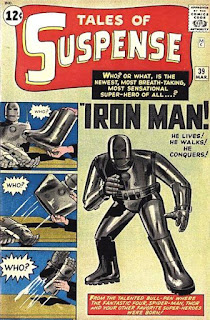Read Black Cat. Vol.1: Grand Theft Marvel for class on Friday, and do the usual Template Responses. We're almost done with the class already! So start thinking about your paper/presentation, due NEXT TUESDAY (not on Monday, as the schedule says--go with the date on the assignment sheet).
In today's class, we talked a bit about the context of Marvel comics, which came out of the exciting youth culture movement of the 1960's. Before this, comics had hit an all-time low, as the Comics Code of 1954 virtually outlawed anything exciting or adult in comics. After WW2, many soldiers returned home reading comics (since they were easy to read and transport on the battlefield), and they wanted more mature subject matter. So crime, romance, and horror comics dominated the field, which were also being read by young children! Dr. Frederic Wertham, a pioneer for censoring the arts, led a campaign to ban the worst comics, and helped create the Comics Code.Here are a few things that the Comics Code prohibited:
•
No comic magazine shall use the word horror or terror in its title.
No comic magazine shall use the word horror or terror in its title.
• All scenes of horror, excessive bloodshed, gory or gruesome crimes, depravity, lust, sadism, masochism shall not be permitted.
• In no case shall evil be presented alluringly, nor so as to injure the sensibilities of the reader.
• Scenes dealing with, or instruments associated with walking dead, torture, vampires and vampirism, ghouls, cannibalism, and werewolfism are prohibited.
• Nudity in any form is prohibited, as is indecent or undue exposure.
• All characters shall be depicted in dress reasonably acceptable to society.
• Sex perversion or any inference to same is strictly forbidden.
This made most comics have to present very boring and childish subject matter to stay on the right side of the code. But in the early 60's, Stan Lee, a budding comics creator, decided to try his own brand of story that would be 'safe' but also appeal to the youth culture that had banded together around Beat poetry and rock and roll. Marvel comics created a series of characters that reflected the kids and teenagers who were still reading comics, and made comics as accessible and 'cool' as The Beatles, The Who, and Jimi Hendrix (among others). As Lee wrote,
"The characters would be the kind I could personally relate to: they’d be flesh and blood, they’d have their faults and foibles, they’d be fallible and feisty, and—most important of all—inside their colorful, costumed booties they’ve still have feet of clay.’”
This is what distinguished Marvel from DC and other companies initially: they wanted stories that reflected real life and were aware of social issues--from racism, women's rights, social conformity, and government authority. Not surprisingly, many of the characters are fighting a war on two fronts: against the bad guys, and against a society that doesn't accept them, either because they're too young, or mutants, or robots, or simply too dangerous for polite society. This is certainly the case with Vision, who has saved the world 37 times(!), but can't really be trusted in a suburban neighborhood, with his synthesoid family that he created like a modern-day Victor Frankenstein!
Many of the themes of the comic can be linked to modern day issues that have nothing to do with superheroes, such as:
* Racism: having "those people" move into the neighborhood
* Police power: Vision's job is to save the world, and sometime believes that this allows him to transgress certain moral and social laws; after all, if he saved every single human being on the planet, can we ever say 'no' to him?
* Being human: how do we define 'humanity'? Is it universal, or local? Absolute or subjective? Could a robot learn to feel like we do? Do we have a monopoly on love? Family? And is "our" culture the only one who feels this way?
* Doing the 'right' thing: when does the right thing for society conflict with the right thing for your family? Isn't it the duty of every man and women to protect their loved ones? Should you sacrifice your family--or yourself--for the general good? Isn't Vision being asked to sacrifice those he loves to be an Avenger?
We also looked at some word + image transitions, to show how complex this book is in telling stories that change depending on the dialogue and narration. Remember that when you add words to a picture, it changes the picture forever. You no longer see the same image.





.jpg)
No comments:
Post a Comment